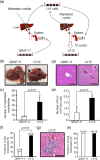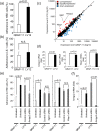Amigo2-upregulation in Tumour Cells Facilitates Their Attachment to Liver Endothelial Cells Resulting in Liver Metastases
- PMID: 28272394
- PMCID: PMC5341090
- DOI: 10.1038/srep43567
Amigo2-upregulation in Tumour Cells Facilitates Their Attachment to Liver Endothelial Cells Resulting in Liver Metastases
Abstract
Since liver metastasis is the main cause of death in cancer patients, we attempted to identify the driver gene involved. QRsP-11 fibrosarcoma cells were injected into the spleens of syngeneic mice to isolate tumour sub-populations that colonize the liver. Cells from liver metastatic nodules were established and subsequently injected intrasplenically for selection. After 12 cycles, the cell subline LV12 was obtained. Intravenous injection of LV12 cells produced more liver metastases than QRsP-11 cells, whereas the incidence of lung metastases was similar to that of QRsP-11 cells. LV12 cells adhered to liver-derived but not to lung-derived endothelial cells. DNA chip analysis showed that amphoterin-induced gene and open reading frame 2 (Amigo2) was overexpressed in LV12 cells. siRNA-mediated knockdown of Amigo2 expression in LV12 cells attenuated liver endothelial cell adhesion. Ex vivo imaging showed that suppression of Amigo2 in luciferase-expressing LV12 cells reduced attachment/metastasis to liver to the same level as that observed with QRsP-11 cells. Forced expression of Amigo2 in QRsP-11 cells increased liver endothelial cell adhesion and liver metastasis. Additionally, Amigo2 expression in human cancers was higher in liver metastatic lesions than in primary lesions. Thus, Amigo2 regulated tumour cell adhesion to liver endothelial cells and formation of liver metastases.
Conflict of interest statement
The authors declare no competing financial interests.
Figures






References
-
- Fidler I. J. & Kripke M. L. Metastasis results from preexisting variant cells within a malignant tumor. Science 197, 893–895 (1977). - PubMed
Publication types
MeSH terms
Substances
LinkOut - more resources
Full Text Sources
Other Literature Sources
Medical
Molecular Biology Databases

